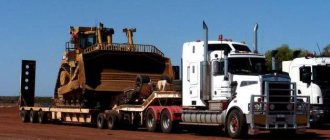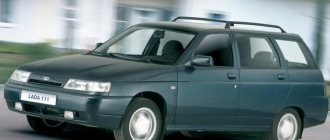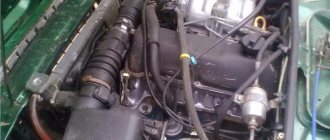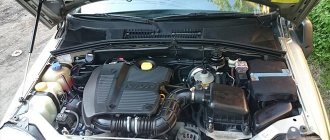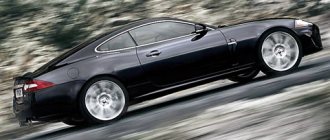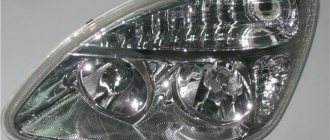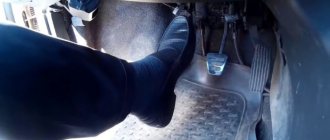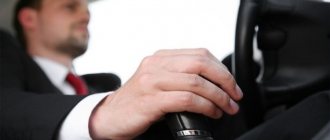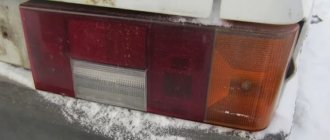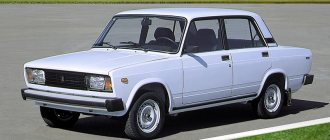How to understand the dimensions of a car - beginner mistakes
The problem of car feel is especially acute for drivers without experience. Beginners who have recently received a driver's license complain: they don't feel the size of the car. In the first year of their practice, motorists are faced with problems of parking and maneuvering in narrow areas: it is difficult for them to turn around in a small area, in limited conditions, among many other obstacles.
When I got behind the wheel for the first time, it seemed to me that I was sitting in the center, and to the right and left of me there was the same distance to the wheels. Until now, after 10 years of driving experience, probably, like many drivers, I feel better the left dimensions - along the driver's seat.
As you can see, first of all you should understand that there is a greater distance to the right wheel than to the left.
The second mistake beginners make is trying to see what is in front of the bumper, looking over the hood. For this reason, many novice drivers move the driver's seat closer to the windshield, resting against the steering wheel. Should not be doing that. The driver needs to look at the road, and not at the wheels. You will be able to feel the size of the car when you gain sufficient skill.
And one more piece of advice – the main thing is to learn how to use mirrors. In the mirror, it seems that neighboring cars are further away than in reality. You think that the car behind you is still far away, since it looks quite small in the mirror, but in reality it is just an optical illusion.
IT IS IMPORTANT TO KNOW. Side and rearview mirrors have a blind spot
A car's blind spot is the space around the car that is not reflected in the mirrors. The driver may not be able to see oncoming vehicles from his seat. Therefore, it is worth remembering that before starting a maneuver, you need to first look in the mirrors several times, making sure that it is safe.
Types of side lights
How to properly start with a manual transmission?
tips for beginners There are several main options depending on the location and requirements for each type. The most common types are:
- Front. The headlights are installed in the housing, but in some older models they were located separately. This option has the following requirements: the light bulb must be of low brightness, white or yellow, this also applies to LED equipment. This is necessary so that drivers understand that this is the front part of a stationary or moving car. Sometimes the dimensions are placed in a separate element or combined with a turn signal (as in the domestic Niva).
- The rear ones are located in the lamps, most often closer to the edge of the car. They should be red, this is the generally accepted designation for the rear of the car. There are no brightness requirements, the main thing is that the light is clearly visible in the dark. There may also be options with a separate layout, this also does not violate the rules.
- Side parking lights were installed on Japanese cars in the 80s. They had a white light and were needed not only to highlight the rear of the car, but also to increase safety when parking and reversing in the dark.
- Parking lights on the cab pillars. Used on some older models and were yellow in color to provide better visibility. Today they are found in some modifications of minibuses, minivans and light trucks.
- Side marker lights are yellow or orange. Installed on trucks, buses and other large vehicles in order to highlight the outline and prevent collisions at night.
- Overhead dimensions are also used on large vehicles. The features of their use differ from the standard ones and are regulated by special rules.
Change lane training
How to learn how to putty car body parts with your own hands.
It will help you figure out how to feel the dimensions of a car by repeating the “parking in a confined space” exercise. Plastic tall objects come to the rescue. On an empty site, they imitate the lines of the curb and the dimensions of standing cars, between which you will have to squeeze. The best option, of course, is to actually drive into a courtyard or parking lot near a hypermarket. But for beginners it is better to practice in desert places first.
For example, let's take the Tiida Nissan model. The dimensions of the car are the same as those of most popular sedans. It is not recommended to choose smaller vehicles for training. The selected one goes to all classic garages, helping in the future to quickly evaluate sufficient quantities from the car's interior.
Training should be carried out at different times of the day. At night, distances begin to be perceived differently due to the headlights. On a bright day, fewer accidents occur, according to statistics. Even professionals make mistakes due to fatigue or after a hectic evening. Similarly, it is worth training constantly so as not to waste money on expensive repairs in the future.
How to feel the dimensions of a car
How to learn to ride a motorcycle
Don't be lazy to spend time on practical exercises. And you can practice in the following way: we take light boxes and build from them something similar to a gate, after which we try to drive through them. You need to devote several hours to this exercise, and if you cope with this task easily, we complicate it, that is, we reduce the distance between the boxes and increase the speed.
Approximately the same principle can be used - using boxes we designate the space into which we will need to move.
You can learn to feel the dimensions of your car in other ways. We draw a line on the asphalt, and then try to drive up close to it, but at the same time you should not touch it with your wheels.
And if you see that you cannot complete this exercise, then you can return to the task with boxes again. Also remember, this exercise will need to be performed until you learn to correctly determine the distance between your vehicle and such a stop line. This task is intended not only for the front wheels, but also for the rear ones.
In addition to these, there are other equally effective exercises. We take chalk and draw lines from the front wheels of the car 7 - 8 meters in front of them. At the same time, try to keep them as parallel to each other as possible. Next, we sit behind the wheel of a car, look for some stationary object that is constantly in front of your eyes (a protrusion on the dashboard can be suitable as such an object), and connect this object with the line that we drew from the right wheel, then along In the same diagram we mark the position of the left wheel. Thanks to this exercise, we will be able to feel the dimensions of our car. We drive away from these lines a little back, then drive your wheels onto them again.
If you combine all the above exercises, then I think you will get used to the dimensions of your car very quickly.
In order to confidently drive a car, you need to feel its dimensions. Its dimensions mean the main dimensions: length, width and height
But knowing specific measurements is not enough; it is important, while inside the car, to understand the real distances from the vehicle body to external obstacles
We will tell you how to feel the car and learn how to drive through even the narrowest places. After all, all vehicles differ in their size, so even if an experienced driver gets behind the wheel of a new vehicle, he will need time to determine the size of the car. Not to mention beginners who find it difficult to understand their place on the road.
Let's try to figure out how to feel a car, what main problems inexperienced drivers face, and how to develop a spatial orientation scheme.
How to feel the dimensions of a car when entering a garage
Latest reviews from Kia Rio car owners
A very difficult task for a beginner is entering a garage. Therefore, in order to feel the dimensions of the car, you must initially enter backwards, guided by the side mirrors, so you will feel the side dimensions.
When you learn to feel the side dimensions, you can drive into the garage from the front. But now you need to feel the distance from the front bumper to the wall. There is a trick for this. It is necessary to tie a rubber ball to the ceiling on a rope, when entering the garage and touching the ball to the windshield, this will be a signal to you that you have driven in as expected.
Rear view mirrors help control the distance between a wall or other object and the rear edge of the car. It is necessary that they are configured correctly. Ideally, you need to see the rear wheels in the mirrors in order to navigate by them.
Be sure to look in your side mirrors when you need to change lanes. Look in the side mirror, if the neighboring car fits completely, then you can change lanes, but if at least part of the car is not noticeable, then when adjusting you can hit it.
Electronic assistants such as parking sensors and a camera will help you navigate and feel the dimensions of the car much faster.
Tags
For better vehicle sensitivity, make marks on the front glass. If you use a large meter or ruler and lean it against the hood, namely where the center of the drive wheel is located, then lean the other end against the front glass. In the place that will be located on the axis of the rear wheel, a mark must be applied with a pencil or a drop of paint. And repeat the same steps with the front tire. Thus, the marks made will help in the sensitivity of dimensions and in any situation in choosing the correct movement, such as parking, entering a narrow garage and other similar places. On a bad and uneven road, the ability to feel the dimensions will also be beneficial.
For a beginner and not only, the dimensions can be felt using the vehicle body. For a novice driver, it is better to install a deflector for visibility and sensitivity of dimensions. Also, many cars are now being produced with voluminous headlights, the so-called bulges. Such convexities serve to more effectively understand the dimensions. And the mirrors will become markers on the sides, with the help of them it is very easy to navigate. It will be difficult to learn to perceive rear dimensions. Owners of crossovers and hatchbacks need to pay attention to the windshield wiper to get their bearings; it will be worse for owners of sedans.
How to learn to feel a car
A few simple exercises will help you learn how to feel the dimensions of a car. Novice drivers should practice spatial orientation skills on a closed race track. It is for this purpose that instructors separate small areas with flags and force students to drive into a conditional box. We suggest watching a video about how to learn to sense dimensions, and then complete several lessons.
To get a consultation
Lesson 1. Visualization
Mentally draw the position of your car relative to the walls of the box, get out of the vehicle and compare the picture presented with the real one. As a rule, it seems to beginners that the edges of the car are much closer to the walls of a conventional garage than they actually are.
Lesson 2. Beacons
Install an antenna at the extreme point of the hood; it will help you understand where the car body ends. At any time you can stop the car, get out of the car and see how close the obstacle is. After this, it will become clear how to do it correctly in a car, how to evaluate the distance and your own dimensions.
Lesson 3. Marking lines
If you are a beginner, to get a feel for the car, mark six lines on the asphalt with chalk or spray paint that:
- cross the front and rear wheels;
- continue the left and right axes;
- outline the rear and front bumpers.
The intersection points of the wheels with the front dashboard can be marked with colored paper or tape on the windshield. The marks will give an idea of the expected trajectory of movement. Thus, you will learn to determine the place on the road along which the car’s wheels will pass. Over time, the tags will no longer be needed; a chain of reactions will be developed in the brain.
Similarly, you can mark the intersection lines of the front and rear bumpers, front and rear wheels. The markings will make it easier to determine and feel the size and trajectory of the car.
Lesson 4. Getting hit by wheels
Place a small piece of cardboard on the road and deliberately try to run over it with each wheel in turn. This exercise will help you develop your sense of wheel line. Practice not only moving forward, but also reversing.
Lesson 5. Snake
Place barriers on the roadway and try to go around the obstacles without hitting them. Lighthouses can be marked with flags, cones, or ordinary plastic bottles.
Try to drive as close to the beacons as possible. Start with simple exercises, and over time make the tasks more difficult for yourself: place the flags closer together and try to guide the car closely between obstacles; "eight" and "snake".
The main advice on how to get used to the dimensions of the car is to practice as much as possible. You can also watch the video, which will help you get acquainted more clearly https://www.youtube.com/watch?v=l4EiBC8tgP8. Ask an experienced driver or instructor for additional training with you on the site.
Skills are acquired through driving. You will learn to intuitively sense the correct distance to obstacles with high accuracy. With experience, you will understand how to navigate the mirrors in the car, how to feel the car.
To get a consultation
Landmarks
We offer you several guidelines to help novice drivers. So, to prepare special markings inside the car, you will need a flat asphalt area, chalk and adhesive tape:
- Park your car in a specific area.
- Use chalk to draw lines forward from the front and rear wheels. They should be quite long, since you will need to view them while sitting in the cockpit.
- After you have drawn the lines, take a seat in the driver's seat. Make yourself comfortable, as if you are about to travel. Now mentally continue the line from the wheels through the hood to the front panel.
- Place a piece of duct tape at the point where it intersects with the windshield. Do the same with the rear wheels.
Such landmarks will help you understand where the wheels are heading when driving. Once you begin to feel the size of your car, these colored stickers can be removed.
Peculiar landmarks for the end of the bumper are the installed antenna or “eyelashes for the headlights.” Using parking sensors or a camera will also be useful. If you have them installed in your car, follow their signals. This will greatly simplify the use of the car.
Problems with perception
The dimensions of trucks are not easy to understand even for experienced drivers. But there are some tricks that allow both beginners and long-distance drivers to perceive the distances to neighboring cars in more detail. To assess the reach of the hood, extend it as far as possible towards the steering wheel. But there are cars where even in this position the nose of the car is not visible. This is where decorative elements on the hood come to the rescue: flags, an antenna, a figurine.
When modernizing a car, they try to install decorative elements on the very edge of the hood. After this innovation, there will be no problems with parking in front. Rearward maneuvers are made easier by fortunately their cost is already low. Models from China will cost several hundred rubles, installation is simple, and you can do it yourself or give the service half of the cost of the gadget for installation.
To improve visibility, many drivers stick convex round mirrors on top of the standard ones. Replace the mirror in the cabin with a viewing one. They install a similar one above the trunk glass in station wagons and minivans. You can use a rear view camera if technically possible.
An easy way to park safely is to have a friend help you. The passenger can get out and manage the process.
Action plan
The first rule of an experienced driver: “If you have doubts due to lack of visibility or due to poor visibility, poor condition, then you need to stop and not be lazy to go outside and look.” Intuitively, while driving, the desire often comes to wait a few seconds and check what is overboard.
This rule must always be followed during any type of maneuver. This way, the highest level of aerobatics is achieved, the safety of your car and the health of passengers. Even when driving through a green light right away, you should once again make sure that traffic is safe by turning your head left and right. So when parking, you should constantly monitor three viewpoints at once. At any second, a restless baby could sit under your bumper in the yard.
In order to park confidently, change lanes and successfully avoid various obstacles on the road, you need to be well oriented in space, feeling the dimensions of your car. This skill comes with experience, but there are some exercises and ways to speed up the “process of getting used to” the car a little. They will be useful for both beginners and experienced drivers who have switched to a new vehicle.
Some drivers manage to learn to feel the dimensions of new cars in the shortest possible time. Others, even those who have driving experience in a particular car, are not always able to confidently estimate distances when driving. Only constant training and regular driving practice will help you get used to the dimensions of any car.
The rapidly increasing pace of life of modern man has naturally led to the fact that the number of cars on modern roads is increasing every day. Every day only new drivers take them out. Your own car is an indispensable assistant, an extremely comfortable and maneuverable means of transportation that allows you to solve many problems.
Moving around the city very often occurs along narrow streets or in dense traffic. High traffic density in a limited space naturally forces drivers to organically feel the dimensions of cars in order to eliminate the possibility of an accident. This is especially necessary for an inexperienced driver who finds it difficult to quickly navigate a traffic situation.
Why is this happening
The first thing to do is evaluate the dimensions of the car when purchasing it. Some people will need an hour or two to figure out how to enter a parking lot or estimate the turning radius. Some people need months to develop confidence during the maneuver.
Perceived by sight through mirrors and glass. Refraction of real objects occurs. Therefore, it will take a lot of time to correctly assess the true distances to the rear bumper and the maximum nose reach of the car. With parking sensors and a camera, the task becomes much easier; the criterion of habit is no longer so important.
However, you should not completely trust the sensors. Often they “swallow” the signal and remain treacherously silent. And having gotten used to the dimensions of the car, a feeling of anxiety will arise in the wrong situation, when a pole or high curb is very close, and the parking sensors are completely calm and there are no objects.
Fast learning
To better master the dimensions of a car, you need to do exercises at least 4-8 times a month for one year. Since the sizes of cars are different, when you purchase a new brand of car, repeat the exercises again. Don't forget that you can take a professional course at a highly specialized driving school. They will teach you extreme driving, understand the dimensions of any vehicle, in any life-threatening situation, and find a way out.
Hitting
The exercise is also very simple, but requires good practice to accurately repeat the results achieved. An empty plastic bottle is placed flat on the platform. Your task is to hit such an object alternately with the left and right front wheel. The exercise may seem incredibly simple, but the sense of size often fails novice drivers, which causes them to miss.
When the exercise is performed flawlessly, it is worth complicating its conditions - hitting it at higher speeds. To consolidate the result, select a deserted section of the road and drive it at a speed of 60 km/h - this will require a very good sense of dimensions. However, it is not recommended to exceed the specified threshold - you may end up in a dangerous situation.
With due diligence, a beginner will quickly learn to feel the dimensions of a car.
In order to perfectly feel the dimensions of the car, you should move on to the third stage - you should hit the bottle while simultaneously making a turn. Even experienced drivers make mistakes in this exercise; due to its complexity, it turns out to be the most effective. The plastic bottle can be replaced with another object, but it should be easily deformed, make a loud sound, but not fly out from under the wheel at high speed. A good substitute for such a beacon for training your sense of size is a cardboard box folded several times.
Why learn to feel the dimensions of a car?
The feeling of your car is necessary for safe driving. A correct understanding of the size of a car will help you park deftly, change lanes, overtake vehicles in front, move in traffic and avoid obstacles.
There are two types of dimensions:
- static;
- dynamic.
Static
– these are the main parameters of the car, its dimensions.
Dynamic
– this is the actual distance from the edge of the body to the conditional obstacle, which is determined in the direction of movement. The driver, as he approaches the actual point, calculates the approximate distance to it. The distance is determined in dynamite - in motion.
It is spatial orientation that will help the driver not to hit curbs and other vehicles. If you brake in time before an obstacle, you can avoid a collision. And an erroneous assessment of the distance leads not only to scratches and other damage to the car’s paintwork, but also to more serious consequences: accidents and dents.
To feel the dimensions, you need to develop a special skill. You can purchase it during driving practice, or work it out specifically. The skill will be useful in various situations:
- in a parking lot - it will help you drive into a narrow space without hitting abandoned cars with your bumper or fender;
- on the road - when changing lanes, estimate the distance to neighboring cars, while maintaining distance in traffic jams, when passing vehicles on narrow sections of the roadway, when giving priority to crossings;
- when entering the garage, the feeling of the car’s own size will tell you when it is necessary to stop the car so that you can close the gate and calmly get out of the car.
To get a consultation
What do driving schools, Internet sites and experienced drivers advise?
- The most banal, but also the most effective, advice is practice. Practice as much as possible, first in the driving school where you are studying, then on your own, at least in an “open field,” setting for yourself some conditional “obstacles” (those that cannot damage the car). Every successful and every failed attempt to park perfectly in a narrow space brings you closer to your cherished skill. For this purpose, you can make unique beacons - thin, light poles fixed in sand-filled bottles; When parking, such poles should be lightly touched by the bumper or fender, but so that they do not fall. If the beacon swings but does not fall, the task is considered perfectly completed.
- At first, you can drive with barely noticeable stickers on the windows - they will show you the approximate line along which the front wheels roll. To glue them correctly, find a spacious area and place the car on it so that the wheels “look” forward. Now draw straight lines under them in the direction of travel (while drawing, imagine that the car should roll exactly along these lines); then sit in the driver's seat and imagine the continuation of these lines on the windshield. Stick small stickers there: they will help you figure out where the front wheels will go now.
Dimensions
The concept of dimensions usually refers to the height, length and width of the car. But the machine is not only in a static position; it also has dynamic dimensions. Those who have carefully studied in a driving school know that there are six main indicators:
- A straight line that continues the wheels – left and right.
- Continuation line of the front bumper.
- Rear bumper.
- Front axle.
- Rear axle.
These parameters are completely different for different brands and not only beginners, but also quite experienced drivers need to get used to them. You can feel them well only after some time has passed - this is the experience of traveling in this particular car. Only after feeling his car, the driver can easily fit into a dense traffic flow or park in a very small and inconvenient space. The same feeling allows you to avoid bumps on the road or move on rough terrain. It’s quite easy to spot a novice driving; many of them try to crane their necks during the trip and try to look at the road in front of the bumper. Such drivers can often see various minor damage to the bumper, front and rear, or headlights. All this is most often the result of unsuccessful parking. You can try to avoid this, because even minor repairs often cost a very tidy sum.
Special markup
In order to learn to feel the dimensions of a car, you can find a small asphalt area on which you should draw with chalk or paint the following lines:
Next, you need to sit in the driver’s seat in the car, adjust the seat and mirrors as if you were about to leave and mentally continue lines A and B. Assume a possible point of intersection of these lines with the dashboard where it connects to the windshield. You can use whatever your heart desires as special tags, for example, colored stickers.
Further, these marks will indicate to the novice driver the continuation lines of the wheels, indicating their intended trajectory. After the driver gets a sense of the car’s dimensions, the tags can be safely deleted, since nothing can erase this knowledge from memory.
Following the same principle, it is necessary to install the marks of both bumpers, as well as the marks of the wheel axle. Especially in the early stages after you start driving, such markings can significantly facilitate the task of parking, as well as determining the dimensions of the car.
Vehicle dimensions
Inexperienced drivers are very easy to spot on the road; they crane their necks forward and try to look not only at their own bumper, but also at what is behind it. This makes it much more difficult to control the distance to another car.
If you find it difficult to cope with the distance, then do the following exercise.
Park in the back next to a parked car. It is advisable that it be a familiar car, and that someone watches this exercise from the side. Approach the car at various distances. Note for yourself where your hood is in relation to the car in front. For example, your hood half covers the rear bumper of the selected car. Go out and see what the distance between you really is. Remember that for sedans, hatchbacks, SUVs, this distance will be different, since the rear number plate can be fixed at different heights. Just experiment, drive closer, further and record the distance. Do the same exercise with the wall in case of this parking option.
When you are moving in reverse, it is even more difficult to feel the dimensions. You can do the above exercise. If you are a hatchback driver, then use the rear brush as a guide. And on a sedan, you will have to take into account, in addition to the distance between cars, the size of your own bumper.
As for parking in reverse, work out a certain pattern.
If you were not taught the rules in practical driving lessons, use the Internet. There are plenty of videos online that will help you practice parking until it becomes automatic. You can also take additional paid lessons to improve your driving skills. It is not very expensive, but the benefits of such targeted activities are enormous.
Determine the side dimensions by looking at the side rear view mirrors.
Try to navigate along the outermost part of the mirror. If, while the cars are actively moving, you need to change lanes, then first look at the car behind you in the side mirror. If you can completely see the car, you can change lanes. If only part of it is visible, it means that it is close to you, and when changing lanes you can catch it.
Exercises to learn to feel the dimensions of a car
Skills need to be constantly improved. It is recommended to do this using a traditional exercise called “snake”. To do this, you need to look for special traffic cones or “chips” between which you will have to maneuver. Don't forget that the front wheels have a larger turning radius than the rear wheels. During the first time you need to move at minimum speed. Then you need to gradually increase the speed, while not forgetting to reduce the gaps between the cones. In addition, you can feel the dimensions of the car using the figure eight exercise.
First, you need to practice moving on an oval, and then go through the entire exercise. It is important to take into account the fact that when driving in reverse, the car has better maneuverability. If you perform too sharp maneuvers, the trajectory of movement will change. Then you need to stop the car, find the main landmarks in the rear-view mirror, and continue the exercise.
Don't forget to learn how to feel the approximate braking distance of a car. To do this, you need to find a suitable flat section of the road and accelerate to the required speed, then sharply press the brake. This exercise should be performed on road sections where there are no other vehicles or pedestrians. Using chalk, you need to make a line on the road. You need to approach it at a minimum distance, but driving onto the line is prohibited. This is quite difficult to do, so instead of a line you can use cardboard boxes or plastic bottles.
With each new trip in your car, you will get used to its dimensions and feel more confident on the road. You just need to not be afraid to be road users and experience will accumulate, helping you cope with any maneuvers.
Share “How to learn to feel the dimensions of a car”
Exercises
Here are a few exercises you can do on your own to improve your driving skills and your sense of the car's dimensions. Cone workout:
- For this exercise you will need: a flat area, cones. In the absence of the latter, you can use plastic bottles filled with sand. And to make them more noticeable, stick long poles with bright pieces of fabric into them. The main condition for homemade cones is excellent visibility.
- Park the car on a level, hard-surfaced area. Place cones around it at a short distance. In front and behind or on the sides - depending on what you want to train. Then start the exercise. Carefully drive up to the cones, as close as possible, but without touching them. To begin with, place the flags further away, then, if you have a successful passage, gradually move them towards the car.
The skill of avoiding potholes on the roads (whatever you say, every motorist needs such exercises):
- For training you will need two plastic bottles. Alternately place one under the right and then under the left wheel.
- Try running over a bottle. You can also practice with the rear wheels.
- Then place two plastic bottles so that they are between the wheels. And drive through them.
- If you didn’t run over bottles, then you won’t be in danger of any potholes on the roads either.
An interesting exercise will help you practice braking and determine the length of your braking distance:
- Build a conditional wall. For it you will need a choice of: empty cardboard boxes, cones. Install them at a distance.
- Then get into the car and pick up speed, heading towards the conditional wall.
- Slow down in front of her. An indicator of your skill will be stopping at the shortest possible distance in front of the wall.
Do the well-known “snake” and “figure eight” exercises. Moreover, practice performing them both in front and in reverse.

